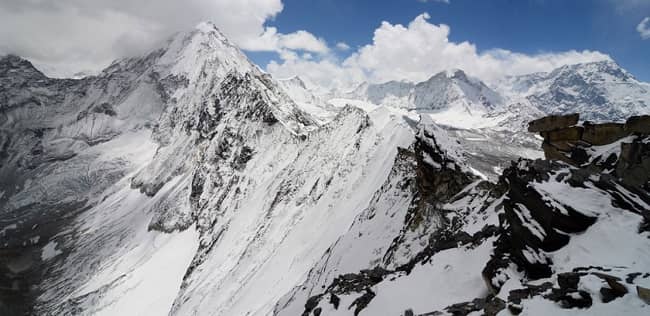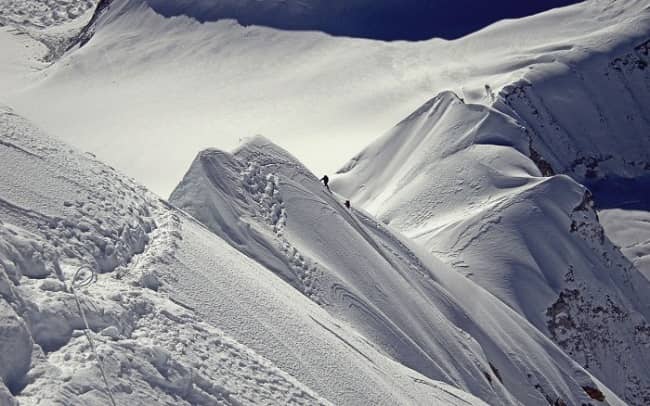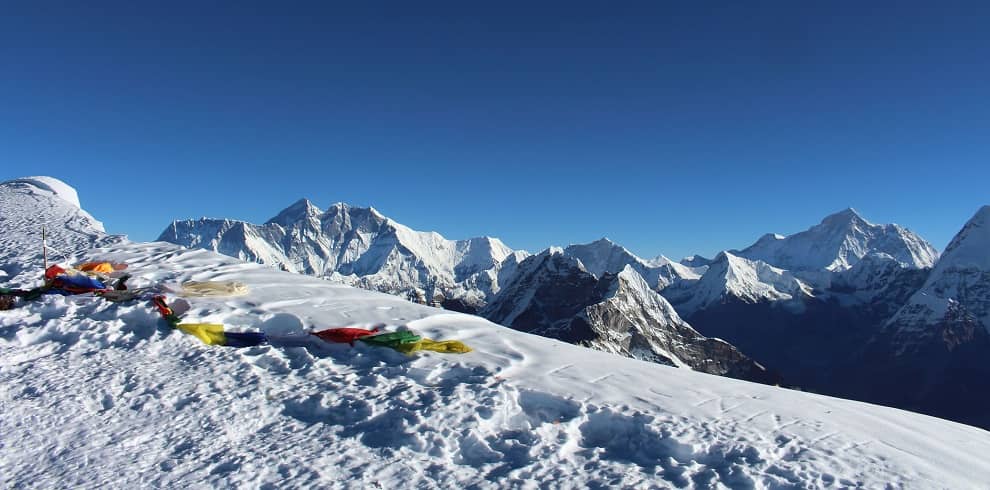Introduction To Mera Peak Climbing & Amphu Lapcha Pass In Nepal
The Mera Peak & Amphu Lapcha Pass combined introductory excursion provides an excellent opportunity to gain valuable mountaineering experience.
The thrill of reaching the summit of Mera peak, which stands at 6,461 meters and is Nepal’s highest, most challenging, and the classic Himalayan trekking peak, is an immensely rewarding achievement with unparalleled scenically magnificent panoramic views of the world’s five 8,000-meter highest mountains- Everest, Kanchenjunga, Makalu, Lhotse, Cho-Oyu, and many other peaks.
Mt. Everest dominates Mera Summit, Nepal’s highest approved trekking peak. In May of 1953, J.O.M Roberts and Sen Tenzing made the first successful ascent of Mera Peak.
The climb to the summit of Mera is not easy, and it necessitates passing several steep and rugged passes. Additionally, integrating this peak with Amphu Laptsa Pass makes the journey the most amazing, thrilling, physically taxing, and immensely rewarding lifetime experience.
Mera Peak is a non-technical peak for first-time as well as experienced trekkers who dare and wish to stand on a Himalayan summit to revel in the success of an amazing once-in-a-lifetime experience.
Following an exhilarating picturesque mountain flight to Lukla’s mountain airfield, the trek begins with less-traveled pathways through lovely forested hillsides in secluded areas of the Hinku valley of Pangkongma and Panch Pokhari on the way to base camp, with adequate gradual acclimatization.
Participating in a climbing training course covering all areas of climbing techniques and skills, glacier travel, rope fixing, ascent, and descent before the summit push to ensure that all of our climbers have the requisite climbing skills and confidence to successfully scale the peak.
We established Mera La base camp at 5415m, and we established Mera Peak high camp at 5800m, which gives a breathtaking panoramic view of the best of its kind, making Mera Peak climbing shorter and more fun.
The summit day begins early in the morning, with a beautiful grandest surrounding majestic highest mountains Kanchanjunga and Makalu to the east, Everest appearing above the gigantic southern aspect of Nuptse and Lhotse to the north- undoubtedly one of the most glorious views in the entire Nepal.
Then there was the crossing of the difficult Amphu Laptsa Pass to stand at the highest point in Everest’s Khumbu region—a moment that will stay with me forever. The journey concludes in Lukla, after a flight to Kathmandu, via Namche Bazaar, the Sherpa heartland, the bustling bazaar, and key entry to the expedition.

This classic path to outstanding high-altitude Mera Peak climbing through Amphu Laptsa Pass is designed to provide the most magnificent and life-changing mountain trip in the Nepal Himalayas.
Highlights Of Mera Peak Climbing & Amphu Lapcha pass In Nepal
- Climb Mera Peak, Nepal’s highest trekking peak (6,461m)
- The courageous crossing of Amphu Lapcha, one of the Himalayas’ most difficult mountain passes
- Trek past glaciers, high-altitude alpine lakes, beautiful rhododendron forests, and traditional Sherpa villages in just 21 days.
- Visit the biodiverse Makalu Barun National Peak and Sagarmatha National Park.
- Take a walk through the Hinku, Hongu, and Dudh Koshi river valleys.
How to Communicate During the Trek?
For a nominal fee, you can use the internet at the lodges, but after you reach high elevations, you’ll have to communicate via phone.
Our office will connect with all of our valued clients by Signal, WhatsApp, phone, Messenger, and other means at least once a day to ensure that they are fine, safe, and comfortable.
You might get some signals along the route, depending on the network you’re using, but they’re not particularly strong at high altitudes. In Kathmandu, though, you may easily obtain a local sim card.
In most cases, you will be able to connect to the internet at all of the lodges/hotels where you will be staying.
Wi-Fi is usually available during the walk-in lodges/lodges for an additional fee.
Extra personal expenses on trekking
In Kathmandu, the clients are responsible for their own meals and lodging. You may book them conveniently online, or we can do it for you if you want.
Similarly, you must pay for visa processing, travel insurance, beverages, trip snacks, hot and cold drinks, souvenirs, and tips to trekking crew members, among other things. Bringing cash (Dollars) and changing it to Rupees is recommended. In the Nepali market, only Rupees are accepted.
Electricity, battery recharge, water on trekking
In all lodges, electricity for camera and phone recharge is available at an additional expense. During the trip, you can either buy pre-packaged mineral water or bring boiled water with you. You will also receive a water-purifying pill.
We advise against drinking water from rivers or taps because the water may be contaminated.

Trek travel insurance
This Trek requires travel insurance. Before beginning the hike, all trekkers must produce a copy of their comprehensive travel insurance policy certificate to us. Medical and emergency repatriation must be covered, as well as helicopter rescue and evacuation costs at high altitudes (up to 6000m).
Based on the experiences of our former clients, we may recommend insurance firms to you. We do not, however, sell insurance coverage. Within a week of booking the trek, we ask that all trek participants provide us with their comprehensive insurance information. In an emergency, we’ll prepare a speedy, successful rescue using your insurance policy and other documentation you supplied us.
Before you acquire travel insurance, call your provider and double-check that it covers helicopter rescue and evacuation up to 6000 meters. Do not rely solely on the material of the insurance company’s website.
How to get a visa for Nepal?
Except for Indian nationals, all foreigners must have a valid visa to enter Nepal. At Tribhuvan International Airport and Nepal’s borders with India and Tibet, you can obtain an on-arrival visa. Visit www.immigration.gov.np. for additional details.
You’ll need a passport that’s valid for at least six months, a passport-size photo, and visa fees to apply for a visa. A 30-day visa costs $50 at the moment (to be paid in cash).
A free visa will be given to children under the age of ten. It is strongly recommended that you examine the current regulations. Visa regulations are subject to change at any time. Citizens of China and members of the South Asian Association for Regional Cooperation (SAARC) (Bangladesh, Bhutan, India, Maldives, Pakistan, and Sri Lanka) are exempt from visa fees.
Certain countries’ citizens may be denied a visa upon arrival. On-arrival visas are not available for citizens of Nigeria, Ghana, Zimbabwe, Swaziland, Cameroon, Somalia, Liberia, Ethiopia, Iraq, Palestine, and Afghanistan. If you are a citizen of one of these countries, please contact the Nepalese Embassy in your country.
Before we embark on our journey, we’ll double-check everything (luggage, equipment, etc.) during our briefing.
Currency Exchange in Nepal | USD to NPR
Nepali Rupees (NPR/Rs) are the local currency.
(1 USD = ~ Rs.124 NPR).
You can exchange major foreign currencies through local banks and legitimate money exchanges in Kathmandu and all over Thamel. Legitimate money exchanges display their ongoing exchange rates visibly to the public.
Please note – only 100 INR (Indian Rupees) and 2000 INR notes are legal in Nepal.
Despite having the security advantage of traveler’s cheques, we prefer cash exchange. It helps avoid lengthy processes and high bank commissions.
You can withdraw cash (in Rupees)from ATMs all over Kathmandu and Thamel itself. Many of these ATMs are open around the clock. The maximum withdrawal amount is 35,000 Rupees for a 500 Rupees processing fee for foreign cards.
If you use the money exchange facilities at banks and financial institutions, they impose a service charge fee of about 4% or more.
During the trek, there are no banks and money exchange services so you should exchange your money in Kathmandu, depending on how much personal expense you require. Only Nepali Rupee is accepted in trekking regions.
Most established banks in Asia will only accept foreign currency notes that are not old, torn, or faded. Please ensure that you have new, clean notes.
How much luggage can I take during the Trek?
Your luggage must not exceed 9 kilograms per trekker. One porter will be allocated to each of the two trekkers, and the total weight of their luggage should not exceed 18 kg. Our porters are never overworked.
You may, however, need to bring your own knapsack or backpack (with valuables or anything important). Carry only what you need. Excess baggage can be safely stored at your hotel or at our store for no charge.
Before we begin the journey, we will double-check everything (luggage, equipment, etc.) during our briefing.
Trek Safely
All of our clients’ safety, security, and happiness are guaranteed by us. We place the highest priority on your safety. For each trip, we will bring all of the essential gear, equipment, and first-aid kits. Our guides and leaders have completed thorough first-aid training.
If a trekker becomes ill as a result of the altitude, we will analyze the situation and keep everyone safe. In the event of an emergency, the rescue chopper will be on standby to transport you back to the lower elevation. Every team member will be together for safety during the walk, and there will be no danger of being lost in hazardous terrains.
Responsible travel
Our philosophy is to photograph the voyage while leaving only footsteps. We believe in sustainable tourism and exclusively offer eco-friendly excursions.
We collaborate with the Kathmandu Environmental Education Project (KEEP) to plan eco-friendly itineraries that satisfy the needs of both tourists and local populations in the trekking areas.
Our Crew
Our knowledgeable guide/Sherpa will accompany us on the trek to ensure your safety and comfort. Your stuff will be carried by porters.
Our members are locals from high Himalayan remote places, and they have exceptional physical endurance at high altitudes.
We value all of our employees, so we pay them well and take care of their insurance, clothing, food, and lodging throughout the trip. When our guides and porters become unwell or injured, they receive medical attention.
Only happy people can make others happy, thus we always make sure that our team members are happy. Members of our trek/expedition team have the following qualifications:
- Authorized Trekking Guide Training Certificate
- Intensive Wilderness First Aid Training
- Fluency in English and another major language
- Conservation and Biodiversity Training
- Experience with rock climbing
Tipping during trek
Tipping is optional and should be dependent on the quality of service received. A tip is an accepted and respected technique in Nepali society to express gratitude (Dhanyabad) for good service.
On the last day of the walk, the majority of our guests offer advice. The amount you tip is totally up to you, and it may be more or less based on your impression of service quality, the length of your trip, your budget, and your appreciation for their efforts.
100% Guaranteed Booking
We are a government-approved and bonded trek and tour company in Nepal. We are also members of the Nepal Mountaineering Association (NMA) and the Trekking Agency Association of Nepal (TAAN) (NMA). As a result, you may book your trek/expedition with complete trust.
As a deposit, we require 10% of the total trip cost. Within a week of booking, please send your documentation, including a copy of your passport, passport-size pictures, travel insurance policy, and arrival and departure flight information.
You can make a 10% deposit via bank transfer, western union, or online payment on our website, and the full balance when you arrive in Nepal. Cash, bank transfer, and credit cards are all acceptable methods of payment. In addition, you will receive payment choices in your email.
Last-minute Trek booking in Nepal
Even though it is always a good idea to plan ahead for your excursions. However, for those who are unable to do so, we provide a special last-minute booking option. To take advantage of this benefit, you must pay the entire trip cost 24 hours before the trek’s departure.
Even while we do our best to plan treks at any time, there is a small potential of a trek delay due to events beyond our control, such as the inability to obtain air tickets or unfavorable weather.
Can I extend my trip?
If you wish to stay in Nepal for a few days after the trip, we can arrange enjoyable activities for you, such as exploring areas in and around Kathmandu, Chitwan jungle safari, paragliding, rafting, canoeing, and so on.
Feedback
We offer a farewell meal at the end of the trek, and we will also award you with a trek completion certificate after dinner (hard copy). It’s also a great opportunity to tell us about your experience and provide us feedback.
You may also visit Rara Lake Trek-Cost, Distance, Itinerary, In Nepal – 15 Days
Overview Of Mera Peak Climbing and Amphu Lapcha Pass
- The Mera Peak Climbing and Amphu Labcha pass consists of Nepal’s most popular peak, Mera, with spectacular views of the high Himalayan panorama, crossing the difficult Amphu Lapcha La Pass, exploring Honku valley, Honku glacier, large frozen lakes, and Pachpokhari (five lakes).
- Ascending Mera Peak (6,476m), Nepal’s highest trekking peak, is simply breathtaking, with five of the world’s top ten highest 8,000m mountains-Everest, Lhotse, Cho-Oyu, Makalu, and Kanchenjunga-and crossing the high spectacular and challenging Amphu Laptsa Pass in the Himalayas-providing an extremely varied mountain adventure experience.
